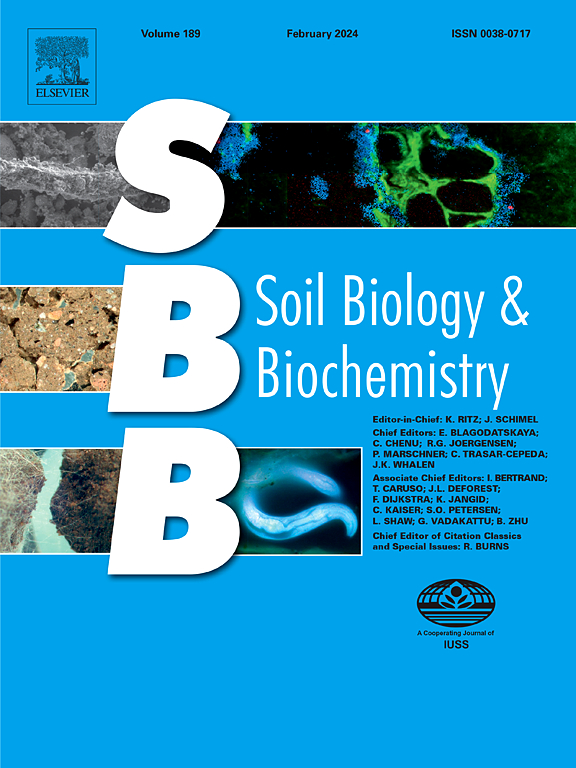矿物、微生物和黑色素驱动真菌坏死团碳和氮在矿物伴生有机质中的差异结合
IF 9.8
1区 农林科学
Q1 SOIL SCIENCE
引用次数: 0
摘要
尽管矿物伴生有机质(mineral-associated有机质,MAOM)在土壤碳(C)和氮(N)的长期持久性中具有重要意义,而且真菌坏死团对这一库也有重要贡献,但控制真菌伴生有机质形成的因素尚不清楚。本研究探讨了真菌坏死团化学,特别是黑色素,如何与土壤矿物性质和微生物群落相互作用,影响MAOM的形成和持久性。我们培养了双色透明丝菌,使其产生具有不同黑色素含量(高或低)的13C和15n标记的坏死块,并将其培养在从印第安纳州6个不同粘土和氧化铁(FeOx)含量的森林中收集的活土壤和蒸压土壤中。38天后,我们发现真菌来源的N比真菌来源的C多7倍,真菌N占MAOM-N库的20%。低黑色素坏死团比高黑色素坏死团形成更多的MAOM- c,尽管总体上MAOM形成的部位水平差异很大。土壤粘土和FeOx含量是MAOM形成的有力预测因子,分别解释了MAOM- c和MAOM- n变化的60%和68%。然而,微生物群落也显著影响MAOM的形成,在蒸压土壤中,MAOM- c的形成增强,MAOM- n的形成减少。腐养真菌相对丰度与MAOM形成呈负相关,细菌丰富度与MAOM形成呈正相关,且这种关系受坏死团黑色素含量的影响。总的来说,本研究揭示了微生物群落和土壤性质相互作用,介导真菌坏死团C和N向MAOM的结合,微生物对C和N的结合有不同的影响,这些过程被坏死团黑化进一步调节。本文章由计算机程序翻译,如有差异,请以英文原文为准。
Minerals, Microbes and Melanin Drive Differential Incorporation of Fungal Necromass Carbon and Nitrogen into Mineral-Associated Organic Matter
Despite the importance of mineral-associated organic matter (MAOM) in long-term soil carbon (C) and nitrogen (N) persistence, and the significant contribution of fungal necromass to this pool, the factors controlling the formation of fungal-derived MAOM remain unclear. This study investigated how fungal necromass chemistry, specifically melanin, interacts with soil mineral properties and microbial communities to influence MAOM formation and persistence. We cultured the fungus Hyaloscypha bicolor to produce 13C- and 15N-labeled necromass with varying melanin content (high or low) and incubated it in both live and autoclaved soils collected from six Indiana forests that differed in their clay and iron oxide (FeOx) content. After 38 days, we found that seven times more fungal-derived N was incorporated into MAOM than fungal-derived C, with fungal N comprising 20% of the MAOM-N pool. Low melanin necromass formed more MAOM-C than high melanin necromass, although site-level differences in overall MAOM formation were substantial. Soil clay and FeOx content were strong predictors of MAOM formation, explaining ∼60% and ∼68% of the variation in MAOM-C and MAOM-N, respectively. However, microbial communities also significantly influenced MAOM formation, with MAOM-C formation enhanced and MAOM-N formation reduced in autoclaved soils. Furthermore, the relative abundance of fungal saprotrophs was negatively correlated, and bacterial richness was positively correlated with MAOM formation, and these relationships were influenced by necromass melanin content. Collectively, this study reveals that microbial communities and soil properties interactively mediate the incorporation of fungal necromass C and N into MAOM, with microbes differentially influencing C and N incorporation, and these processes being further modulated by necromass melanization.
求助全文
通过发布文献求助,成功后即可免费获取论文全文。
去求助
来源期刊

Soil Biology & Biochemistry
农林科学-土壤科学
CiteScore
16.90
自引率
9.30%
发文量
312
审稿时长
49 days
期刊介绍:
Soil Biology & Biochemistry publishes original research articles of international significance focusing on biological processes in soil and their applications to soil and environmental quality. Major topics include the ecology and biochemical processes of soil organisms, their effects on the environment, and interactions with plants. The journal also welcomes state-of-the-art reviews and discussions on contemporary research in soil biology and biochemistry.
 求助内容:
求助内容: 应助结果提醒方式:
应助结果提醒方式:


